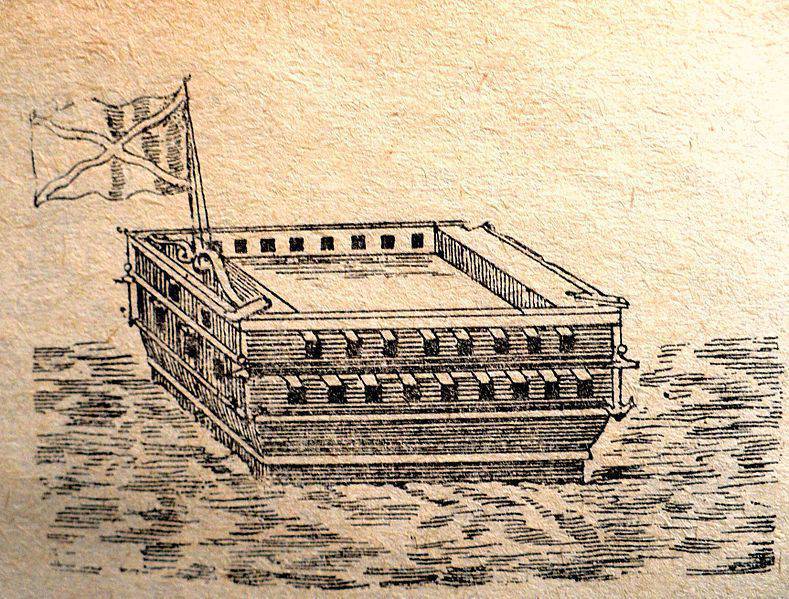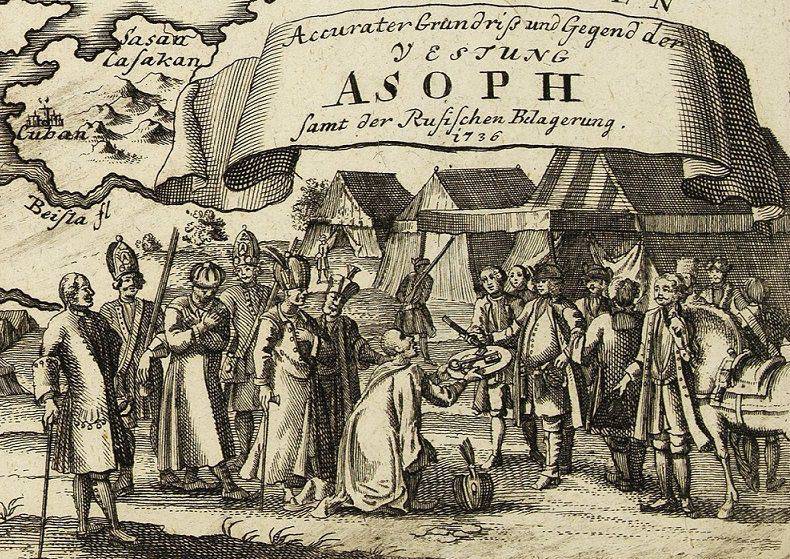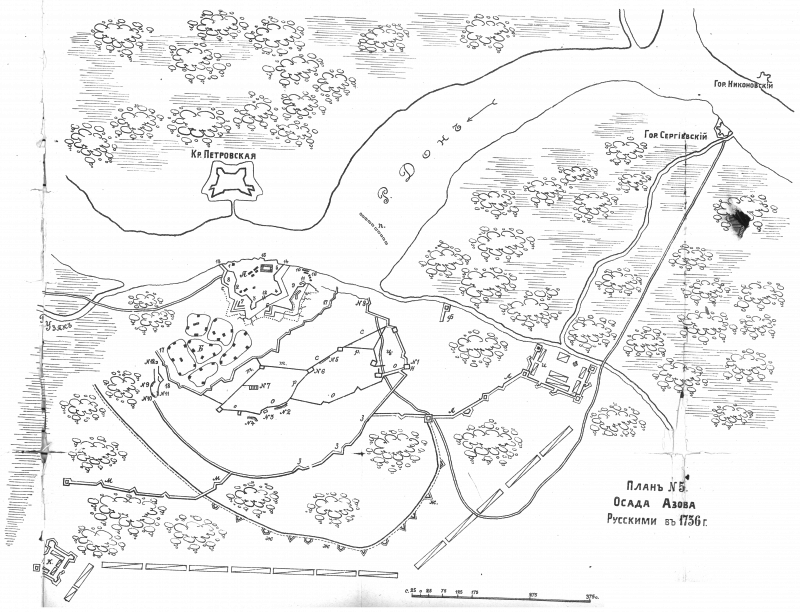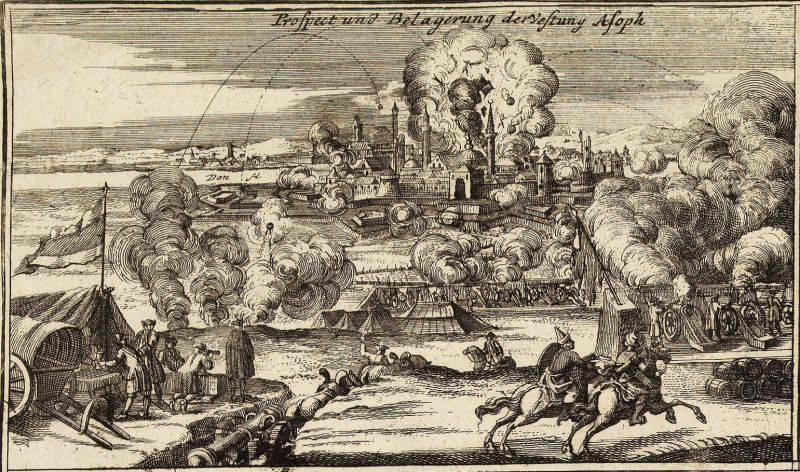Azov campaign 1736
At the end of February, 1736, while in St. Petersburg they were still arguing about the campaign plan, Field Marshal Minikh left the city of Izyum and a week later arrived at the fortress of St. Anne. Here he learned from the Cossacks that the enemy garrison of the Azov fortress does not exceed two thousand people, and the Turks cannot deliver reinforcements to the fortress, as the “high weather” stands, that is, the wind blows from the headwaters of the Don, preventing the ships from entering the river. The Cossacks also reported that the land had already thawed, which means it is possible to build earthworks.
Therefore, Minich made adjustments to the plan of operation: he decides to urgently send forward the Don Cossacks and Kalmyks under the command of sergeant-general Krasnoshchekov, so that they attack the Tatars, who were wandering near Azov, and did not give them support for the garrison of the fortress. To help the Don'ts for this operation, it was decided to attract Kabardians and Terek Cossacks, to whom they sent appropriate instructions. At the same time, the field marshal ordered troops in the fortress of St. Anne to prepare for their campaign, despite the lack of provisions and personnel in the regiments. He decided to personally begin the siege with the forces that he had at hand: a total of 18,5 thousands of people. Minikh himself argued this decision as a convenient coincidence, but many contemporaries believed that the ambitious commander himself decided to take Azov in order not to share fame with Lassi, who was to command the Don Army.
13 (24) March, the vanguard of the Russian troops crossed over to the left bank of the Don. The next day, an engineer-ensign Malygin reported to Minikh that the two locks protecting the approaches to Azov on both sides of the Don (the Russians called these fortifications were half-destroyed), and their garrisons are small. To capture these fortifications, Field Marshal singled out a special detachment under the command of Major General Ulrich von Sprereyter (200 grenadier, 300 fusilier, 100 miners and artillery), and 1200 of the Don Cossacks, the ataman Ivan Frolov, and himself at the head of 2,5, thousands of foot soldiers. On the way, the Cossacks of Krasnoshchekov and several other infantry detachments joined him. As a result, when Field Marshal 19 (30) March camped at Azov, only 5 thousand people were at his disposal, that is, less than a third of the forces with which he planned to besiege the enemy fortress.
A blizzard twice tore down the storming of castles. Only on the night of 20 (31) in March, the Spreutter squad attacked and captured the fortifications on the left bank of the Don. After that he sent a proposal for the surrender to the right-bank kalanch garrison on the condition of issue weapons and the departure of the garrison in Azov. The commandant of the right bank Kalancha Ada-Bash accepted the conditions and passed the fortifications. It should be noted that during these battles, the war has not yet been declared, and the Turkish commandant of Azov was completely taken aback. Only having lost the advanced fortifications, he ordered to set fire to the forstadt and open artillery fire on the besieging forces.
After detailed reconnaissance, it became clear to Munnich that the garrison of the Turkish fortress was much larger than it was thought and with the forces that could not be broken. He decided to organize the proper siege of the fortress. Russian troops built a camp near the Don and Azov gardens, in a place where the soldiers found enough good water, firewood, straw and reeds. Field Marshal, in order to strengthen the blockade of Azov, ordered von Sparreiter, seize the fortress Buttercup. The fortress was small, the Buttercup garrison numbered only a hundred janissaries. However, the fortress was of strategic importance, since it was located north of Azov and dominated the mouth of the Dead Donets (one of the Don branches), covering the exit to the Sea of Azov, and there were a lot of supplies in it in case of military expansion during the war.
In the evening of March 23 (April 3), von Spreutter's detachment approached Buttercup from the east. At the same time, the Don Cossacks penetrated by boat into the mouth of the Dead Donets from the sea and appeared at the western wall of the fortress. The Ottomans panicked and ran. However, they were captured by the Cossacks. Russian captured in the fortress 20 guns and supplies. As a result, Azov was surrounded on all sides and the Russian troops were able to reach the sea. For this, 1000 Cossacks were allocated, who went to the sea by boat. They were supposed to build redoubts and place 14 guns to prevent assistance to Azov from the sea.
Minikh strengthened the position around Azov and began bombing the fortress. Since the siege artillery to Azov has not yet arrived, so she had to fire the fortress from cannons, shot from the walls of the fortress of St. Anne. March 24 (April 5) Major General Levashov arrived in the Russian camp, to whom Minnich surrendered command. March 26 (April 7) Field Marshal left the camp near Azov to go to Tsarichanka and lead a campaign to the Crimea. It should be noted that, despite the haste of the Azov campaign and the small number of Russian forces, Minich coped well with his work. The advanced fortifications of the Azov Fortress (two kalanches and Buttercup), which, if the Ottomans had prepared for defense, could have created serious problems for the Russian army, were taken quickly and almost without loss, the Don Cossacks drove the Tatars away from the city, depriving the Turkish garrison of support, the right siege.
Leaving the camp, the Russian commander-in-chief drew up a detailed instruction for Levashov on concentrating the necessary number of troops near Azov, delivering siege weapons, building batteries at the mouth of the Don, and protecting the camp itself with retractments and redoubts. At the same time nothing was said about the assault. Azov was planning to take the correct siege, as there were few troops for a decisive assault. Not having sufficient forces for active operations against Azov, Levashov concentrated on securing the blockade (if possible, narrowing it), building additional fortifications for the camp and supplying supplies and materials necessary for the siege.
Plan №5. Siege of Azov by the Russians in 1736. Source: Bayov A.K. The Russian army in the reign of Empress Anna Ioannovna. War of Russia with Turkey in 1736-1739
The beginning of the siege
In early April, Russian troops completed the construction of the Main Camp, which was located a mile and a half to the east of the fortress, on the banks of the Azovka River, the left tributary of the Don. Another camp was built southwest of Azov, in the valley of the Uzyak River. Both camps were protected by retrospectives, armed with serfs and served as strongholds on the flanks of the siege line. Between the camps stretched lines of redoubts, redans and flushes. A particularly important role was assigned to four redoubts on the right flank of the besiegers, in which they placed three mortars for firing huge bombs weighing five poods each (80 kg.) Brought from St. Anne's fortress. 26 March these powerful guns opened fire.
The Ottomans, having recovered from the first fear and seeing that there were few Russians, began to make strong forays. 3 (14) April, the Azov garrison for the first time decided on a major raid. Out of the fortress, there were over 600 foot soldiers and mounted soldiers who attacked a Russian wagon train, which was protected by only hundreds of escorts. The soldiers, however, did not become confused, and having built a wagenburg out of carts, they fought back for two hours, until the Cossacks came to their aid. 5 (16) April Turks made a new raid. This time, even more troops took part in it - 500 foot janissaries and over 1 thousand horsemen. The main blow of the Turkish troops was directed against the most dangerous for the fortress Russian position - on the right flank of the Russian position, where they were located on the redoubts with mortars, which caused great damage to Azov. The Turkish cavalry attacked the Don Cossacks, who stood between the redoubts, and the Janissaries struck at the fortifications. But, despite all the efforts of the Janissaries, they failed to take the redoubts. April 25 (May 6) a large detachment of Crimean Tatars came to the raid. Levashov learned in advance about the attack of the enemy and singled out 400 Cossacks in an ambush. Having missed the Tatars, the Cossacks attacked them from the flank and to the rear, knocking over the enemy, who was forced to flee. After these three unsuccessful attacks, the Turkish garrison for some time refused to take action.
4 (15) in May under the Azov arrived P.P. Lassi, who had just returned from the march on the Rhine and received the rank of field marshal. Along the way, he experienced many adventures along the way. Another 17 in March, Lassi left his army near Vienna and set off for Tsarichanka on mail horses, overcoming 80 km in a day (the commander was 58 a year). With an incredible speed for that time, he reached the location of the Dnieper army. Lassi in Tsaritsynka met with Minikh, discussing the plan of the siege. Hurrying to Azov, Lassi on the way from Buzova to Izyum was attacked by the Crimean Tatars. With the field marshal, there were only 40 man of horse landmilitia. Having lost the 20 man from the convoy, his crew and belongings on the 10 thousand rubles, the field marshal managed to get away on horseback. After that, he did not dare to go on the steppe ahead of the Ukrainian line, and drove after the line to the fortress of Sv. Anna, and from there to Azov.
It must be said that Lassi was a very extraordinary person. Irishman by nationality, he still at a young age took part in the War of the Two Kings in Ireland, emigrated to France, joined the Irish squad, participated in a number of campaigns in Europe. Lassi in the 1700 year entered the Russian service, participated in the Northern War, Prut and Persian campaigns. In 1727, he carried out a very delicate order of Menshikov, expelling from Kurland the claim for the ducal throne Moritz of Saxony. In 1733, he was sent by the corps commander sent to Rzeczpospolita to support August III against Stanislav Leschinsky. He fulfilled his mission successfully. The troops under the command of Lassi began the siege of Danzig. In 1735, Lassi commanded an army sent by the Russian government to help the Austrians. The Rhine campaign was completed successfully. The emergence of Russian troops in Germany forced the enemies of Austria to bow to peace. Many contemporaries compared Lassi to Minich and the conclusions were often not in favor of the latter. In their opinion, Lassi was not inferior to Munnich in military ability, and won by being indifferent to court intrigues.

44-gun pram. Large flat-bottomed artillery sailing-rowing vessel, used as a floating battery
Continuation of the operation
Arriving at the location of the army, Earl Lassi on the same day examined the location of his troops, and made a reconnaissance of the positions of the enemy and the environs of Azov. By this time, the army entrusted to Count Lassi consisted of 8,4 thousand men in regular regiments and 3,3 thousand men of irregular troops (Cossacks and Kalmyks). The fleet was still on the road, and the army had 30 pebbles (semi-galer) and 6 half-frames at disposal. On the day of Lassi's arrival, Rear Admiral Bradal arrived at the tower with several galleys. After inspecting the troops, Lassi noted with chagrin that they were "quite unable". In the regiments, especially those who returned from Persia, there were many sick soldiers and very young recruits, who were not yet accustomed to the service. There was not enough food, clothing, ammunition and even guns. Irregular troops for the most part consisted of old or very young people, who, according to field marshal, “are not only against the enemy to work, and are not suitable for use in work”.
This state of the army is explained by the fact that Minich, in order to ensure the effect of surprise, spoke before the completion of the preparation and the utterly slowness of the Russian bureaucracy. All orders for the delivery of necessary supplies to the army were executed very slowly, accompanied by eternal red tape. Field Marshal in his reports constantly asked to put pressure on anyone who should and "provide Your Imperial Majesty with strong Decrees."
After examining the state of defense of Azov, Lassi came to the conclusion that "the city, apparently, is in a solid state ...". However, he did not abandon the siege. After May 5 (16) reconnaissance by engineers, under the command of Quartermaster-General Baron Peter de Brigny, the attack was decided to be carried out from two sides. The main attack was to be carried out on the western front of the Azov fortress, from the left flank of the besieging army, and a demonstrative one against the eastern front, on Alekseevsky kronverk, from the right flank. Lieutenant-General Artemy Zagryazhsky and Rear Admiral Bredal were ordered to go soon to Azov with regiments and fleet. On May 8 (19), Lassie switched to action. In the direction of the western and eastern faces of the Azov fortress, apros began to dig. Seeing this, 800 Turkish soldiers immediately made a sortie, but were repelled. After that, Lassie ordered that not only the guards, but also people performing engineering work, go out to work with guns.
Bredal ships began to approach, which improved the supply of troops. The blockade of the fortress from the sea intensified. Bredal’s ships were to interrupt Azov’s boat post, part of the fleet was sent to the mouth of the Don to block the way of the Turkish fleet. The artillery power of the Russian army has become stronger. In general, all ships had over 200 guns in caliber of 18 and 24 pounds. Having received the siege artillery, the Russian troops from 13 (24) May began to strengthen the bombing of the fortress. The city was shelled from the side of the river. 1 (12) of June fire opened one pram, and from 2 (13) of June three pram fired. The shelling of naval artillery was successful, so the command added six more Prams to them, who fired before the day the surrender of the fortress was fired. The Turks responded with fire of their own artillery, but rather weakly.
16 (27) May Turks made a big raid in order to prevent siege work. More than 2 thousand soldiers left the fortress. The Ottomans attacked the left flank of the position, and began to push the Russian infantry. The position was saved by Lassi himself. He personally led the grenadier and 500 dragoons to attack 100, outran the attackers from the flank, knocked them over and drove them to the fortress. The fight lasted five hours. On the Russian side, 2 officer and 19 soldiers were killed. More 191 people were injured. Sending 6 pram under the command of Lieutenant Kostomarov to the mouth of the Don turned out to be very timely, as the fleet of the Kapudan Pasha itself soon appeared. However, because of the shallow water, the Ottoman ships could not move along the river, and the presence of Russian pram did not allow the Turks to enter the mouth of the boats. Unable to break through to Azov, Kaputan Pasha retreated. 3 (14) June, the Ottomans made another big sortie, striking the left flank. The Russians killed 33 man, injured 823 man.
Surrender fortress
To the 4 (15) of June, the Russian apros were only forty steps away from the earthen vorstadt, which covered the approaches to the fortress. Four days later, one of the Russian shells hit the powder cellar of the fortress directly. The strongest explosion occurred, as a result of which, in Azov, five mosques were destroyed, more than one hundred houses and 300 people died.
By 10 (21) June, the apros reached the bottom of the forstadt. Wanting to accelerate the course of events, the commander Lassi ordered to prepare for an open assault on Turkish fortifications. The solution of this task was assigned to a special squad of 300 grenadiers and 700 fuzillers under the command of Colonel Loman. On the night of 17 on 18 June, under the cover of artillery fire from all the batteries and ships stationed on the Don, Loman’s assault squad moved into the attack. The Turks fiercely defended and blew up two mines, but, as Lassi subsequently reported, "with considerable difficulty and with the battle by our people, the adjacent palisades from Azov were taken". The losses of the Russians during the attack were small: 5 soldiers killed, 38 soldiers and 2 officer wounded. The total number of Lassi army by that time reached 25 thousand people.
After the fall of vorstadt, the commandant of the fortress Mustafa-aga sent a letter to the Russian camp with a proposal to surrender the city. 19 June negotiations began. At first the Russian commander insisted on total surrender, but the Ottomans resolutely refused. The commandant even said that he would prefer to "die under the ruins of the fortress." In the end, the Azov garrison was allowed to proceed under the escort of Russian troops in the Turkish fortress of Atsuk. The garrison left the fortress without military honors with the condition not to fight against the Russians for one year; the military was allowed to leave personal weapons in the amount of one rifle, bow, pistol and sabers; all state weapons remained the Russian army; the artillery, its accessories, provisions, with the exception of the amount of Turkish soldiers needed for the transfer during the transition, the powder cellars and mines remained Russian; Turkish nationals could stay in the city 14 days to complete their affairs, they were provided with security and fair treatment of the property. Before the return of the convoy, commanded by Admiral Bradal, the three Turkish commanders remained hostage. The city of Azov was considered to have passed "into the citizenship of Her Imperial Majesty."
8 (19) July, the Turkish garrison as part of the 3463 man left the fortress. Together with the garrison, the 2233 man of the townspeople and the 121 merchant from Armenians and Greeks left. In the city, 119 prisoners of various nations were released. The trophies of the Russian army were: 136 copper cannons, 68 cast iron, 6 copper shotguns, 24 cast iron shotgun, 2 copper mortars, 5 cast iron mortars, 23 copper base and a large amount of ammunition.
Image of the Siege of Azov in the year 1736. The moment of explosion of the powder cellar is shown.
Results
According to the prisoners, before the start of the siege, the garrison of the Azov fortress was about six thousand people (and not two thousand, as Minikh thought). That is, at the beginning of the siege, when Minikh had only about 5 thousand people, the Russian army was inferior in numbers to the Turkish. The losses of the Turkish army amounted to 2487 people. In addition, residents of the city died and died from 1200 diseases. Russians lost 295 people killed and dead from injuries, 1343 people injured, 22 missing. In total, over 17 thousands of cannonballs and about 5 thousands of bombs were fired at the Turkish citadel.
On the whole, the siege and capture of the Azov fortress became a real anthem of a regular siege with complete blocking, the erection of numerous engineering structures and heavy shelling of the enemy. As during the Azov campaign 1696, the success of the operation ensured the active interaction of the army and navy. The ground forces and the fleet completely blocked the fortresses from land and water. The approaching Turkish fleet was unable to transfer reinforcements and supplies, which predetermined the outcome of the siege. The capture of the Azov Fortress was of strategic importance. The Russian Empire received a powerful fortress at the mouth of the Don and access to the Sea of Azov.
Taking the Turkish fortress, Lassi gave the troops some time to rest. Already 4 (14) in July, the field marshal instructed Lieutenant-General Douglas with the Kazan and Nizhny Novgorod dragoon regiments to go, through the city of Raisin, to Perekop to help the army of Minich. Then he himself went there, with one dragoon and eight infantry regiments. The commandant of Azov was Lieutenant-General Zagryazhsky. General command in this direction (in Azov and in the fortress of St. Anne) took over Levashov.

The capitulation of Azov in 1736. Azov Pasha Mustafa Aga hands the keys to the city to Field Marshal Count Lassi. Fragment of German engraving 1740 of the year
To be continued ...
- Alexander Samsonov
- Russian-Turkish war 1735 — 1739
Russian-Turkish war 1735 — 1739 State of the Russian army
The extinction of military power and the era of tulips in the Ottoman Empire
Causes of the Russian-Turkish war
France vs Russia. Fight for Poland
Trek Leontiev. Minich's plan: to the Crimea, Azov and Constantinople


Information